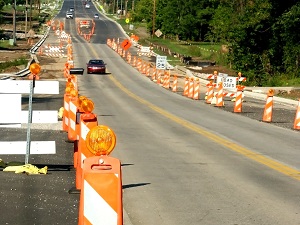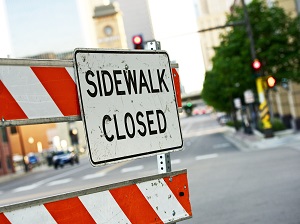With more than 600 fatal work zone incidents occurring every year, designing and implementing safe and effective temporary traffic control (TTC) for work zones does save lives.

What is a Temporary Traffic Control Zone?
A temporary traffic control zone, also known as a TTC zone, is an area of a roadway where the usual driving conditions are changed because of a work zone in the area. The main function of TTC is to provide for the safe and effective movement of road users, including drivers, cyclists and pedestrians, through or around TTC zones while also protecting workers and equipment in the work zone.
Construction, maintenance, and utility work projects must plan for unexpected or unusual situations that their work will create for road users driving nearby.

Temporary Traffic Control Zone Fundamentals
Approach all activities in work zones involving TTC by focusing on these seven fundamental principles:
- Develop a plan to make sure that motorists, bicyclists, pedestrians and workers are safe while the work zone is in place.
- As much as possible, avoid interrupting the normal flow of traffic through the work zone and in other areas near the work zone.
- Guide traffic in a clear and positive manner as it approaches the work zone to avoid confusing the drivers, which can lead to incidents.
- Inspect the work zone both during the day, and again at night, to make sure that the traffic control measures are effective in bright daylight conditions, as well as low light conditions.
- Maintain all traffic control devices such as lights, barrels, cones, signs, and barriers so that they are clean visible, and effective.
- Train all members of the team that will be working inside of the work zone, including supervisors, management, and field personnel, on the proper techniques of temporary traffic control.
- Communicate with the public before, during, and after the work is performed to help ensure that their safety, as well as the safety of the workers, is considered at all times.

The temporary traffic control implemented for work zones should be designed in such a way that minimizes disruption to usual traffic patterns. General guidance suggests that drivers will only reduce their speeds if they clearly perceive a need to do so. For this reason, reducing the speed limit in the work zone should be avoided, if possible. Abrupt changes to the usual flow of traffic, including lane narrowing, dropped lanes or rapid lane shifts, should be avoided.
Work that requires TTC should be scheduled in a manner that minimizes the need for lane closures or alternate routes, while still getting the work completed as quickly as possible. Lane closures on high-volume roadways should be scheduled during off-peak hours. Consider attempting to reduce the traffic volume through the work zone by encouraging alternative routes through signage or by closing selected access points to the area.
MUTCD Standard 6D.01-04 If the TTC zone affects the movement of pedestrians, adequate pedestrian access and walkways shall be provided. If the TTC zone affects an accessible and detectable pedestrian facility, the accessibility and detectability shall be maintained along the alternate pedestrian route.
Bicyclists and pedestrians, including those with disabilities, should be provided access and safe passage through a TTC area, if such passage is allowed during normal conditions.

Traffic Control Training Requirements
Training is a fundamental component of successful temporary traffic control measures for work zones. Each person whose actions affect work zone safety in any way, from management to flaggers to field workers, should receive appropriate training pertaining to their role. For example, management and supervisors need training to ensure that they can plan in advance for changes to the work zone, ensure the correct number of workers are scheduled for flagging, and required safety equipment is planned for in the budget.
Only individuals who are trained in proper TTC guidelines, including the main principles of TTC, should supervise the selection, placement and maintenance of traffic control devices used for active work zones.
MUTCD Standard 6D.03-04 All workers, including emergency responders, within the right-of-way who are exposed either to traffic (vehicles using the highway for purposes of travel) or to work vehicles and construction equipment within the TTC zone shall wear high-visibility safety apparel.
All personnel in or near a work zone should be visible for the current lighting and weather conditions by wearing the proper high-visibility attire.

Protecting the Public
The protection of the public, motorists, and traffic driving by a job site or work zone is the first priority when establishing temporary traffic control. By communicating to drivers, the safe way to proceed through or around the work zone, a safer job site is created and serious hazards can be prevented.
OSHA Standard 1926.200(g)(1) At points of hazard, construction areas shall be posted with legible traffic control signs and protected by traffic control devices.
Before any detour is created, all necessary signs should be in place. TTC signs and devices should be used in a way that get the motorist’s attention and provide easy to understand direction. When work is suspended, TTC signs and devices must be covered or removed and when work is completed, then they must be removed from the route.
MUTCD Standard 6B.01-08 Before any new detour or temporary route is opened to traffic, all necessary signs shall be in place. 09 All TTC devices shall be removed as soon as practical when they are no longer needed. When work is suspended for short periods of time, TTC devices that are no longer appropriate shall be removed or covered.
Protecting Workers in a Work Zone
An essential step of implementing TTC zones is to create a barrier between motorists and the work zone to adequately protect workers. This allows workers to safely work while motorists travel through the TTC zone. TTC zones present conditions that may be unexpected by the road user. Workers on or near the roadway may face additional hazards if the TTC zone is not adequately designed for worker safety.

.jpg)

